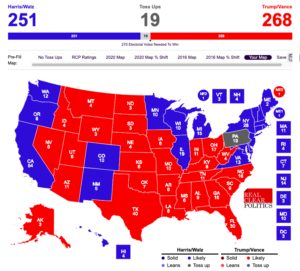The upcoming US Presidential elections, set to take place in the next few days, seem both simple and complex. Simple, because it all boils down to just one state – Pennsylvania. In the 2020 elections, Joe Biden struggled to scrape through five swing states – Pennsylvania, Georgia, Michigan, Wisconsin, and Arizona. These five states determined the results of the last two elections. In 2016, Hillary Clinton lost all of these states to Trump, while in 2020, Biden won all five against Trump. Although it initially appeared that these states would play the same role this time around, a closer look at the electoral map suggests that it will ultimately come down to Pennsylvania, where the tipping point lies for both candidates.
Georgia and Arizona appear to be leaning towards Trump, while Harris may take Wisconsin and Michigan. Even as I divide these states into two camps, I am more confident that Trump will secure his two states, while Harris may face difficulties in securing hers. It’s possible that Harris may falter in Wisconsin, a state that Biden won by only twenty thousand votes. This implies that if just ten thousand of Biden’s votes shift to Trump, it would result in a win for Trump. Nevertheless, if I adopt an optimistic forecast for Harris, this is how the electoral map appears:

On the other hand, the elections are complex because it is difficult to determine which way the wind is blowing. As seen in both 2016 and 2020, Trump performs better in actual results compared to opinion polls. However, pollsters now claim to have adjusted for this discrepancy, and this year’s polls are said to reflect a more accurate picture. What is that picture? That the elections remain unpredictable.
The only thing going well for Trump is that he is as unconventional as any candidate can get. He has always come across as unpolished and brute, which is what half of the US loves. This quality is sufficient for all of them to ignore any number of fallacies he may show. Democrats have hardly found a way to deal with this. Neither their reason nor their articulation is pleasing enough for his supporter to reconsider his support. When Trump is on the ballot, the US does not vote as per the standardised en-blocs of pro-guns or anti-guns, pro-abortion or anti-abortion, or pro-tax cuts or anti-tax cuts. It comes down to perceptions that societal groups have of Trump.
Donald Trump is an absolutely fascinating candidate. He possesses characteristics that one may dislike but cannot ignore. Whatever the election results may show, he may, for historical purposes, become the biggest exception to voting patterns in the US. He attracts a notable share of the black vote, despite his racial stance and his opponent being half-black. He receives strong support from the working class, a demographic that Democrats from Clinton in 1992 to Obama in 2012 claimed. Immigrants from Mexico and India support him despite his call for “America for Americans”, a clear attack to what the right sees as un-American.
He is a resilient man with a level of impunity unmatched by any other candidate. He is evaluated with the same tolerance as a drunk driver, to whom we feel grateful if he avoids a crash. Meanwhile, Kamala Harris is more akin to a sober Formula 1 driver who would face intense scrutiny for every minor error while driving a hatchback through a crowded street. No reality show will ever come close to the drama of this year’s elections.
All the experts, pollsters, and commentators are scrambling to say anything definitive because there is nothing definitive about this election. Some discussions, especially on the 538 Podcasts, have even gone on to look at the weather forecast of Philadelphia, the capital of Pennsylvania, to see if it would rain on the election day, the 5th of November. And if it does, it is likely that Trump may win because those who are likely to vote for Harris may not be motivated enough to beat the rain and go out to vote. I am sure some analyst will soon release a detailed margin of vote-shift for every millimeter of rain Pennsylvania receives. Truly, we have saturated all data points.
With only a few days remaining, I am engrossed in everything related to the US elections. As in 2020, my body clock has adjusted to the New York time zone. And just as I did in 2016, I am hoping that Trump will be victorious once more — not for any policy reasons, but because his presence in the White House would make America interesting again.